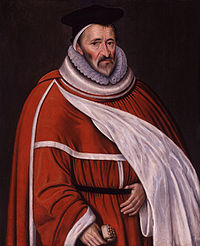
Edmund Anderson
Encyclopedia

Elizabeth I of England
Elizabeth I was queen regnant of England and Ireland from 17 November 1558 until her death. Sometimes called The Virgin Queen, Gloriana, or Good Queen Bess, Elizabeth was the fifth and last monarch of the Tudor dynasty...
, sat as judge at the trial of Mary, Queen of Scots.
Life
The Anderson family originated in Scotland and then came to NorthumberlandNorthumberland
Northumberland is the northernmost ceremonial county and a unitary district in North East England. For Eurostat purposes Northumberland is a NUTS 3 region and is one of three boroughs or unitary districts that comprise the "Northumberland and Tyne and Wear" NUTS 2 region...
. They settled in Lincolnshire
Lincolnshire
Lincolnshire is a county in the east of England. It borders Norfolk to the south east, Cambridgeshire to the south, Rutland to the south west, Leicestershire and Nottinghamshire to the west, South Yorkshire to the north west, and the East Riding of Yorkshire to the north. It also borders...
in the 14th century and became a prominent family there.
Sir Edmund Anderson, son of Edward Anderson, was born in Flixborough
Flixborough
Flixborough is a village and civil parish in North Lincolnshire, England. It is situated near to the River Trent, about 3 miles north-west of Scunthorpe. The village is noted for the 1974 Flixborough disaster....
in Lincolnshire c. 1530. He received the first part of his education in the country and then spent a brief period at Lincoln College, Oxford
Lincoln College, Oxford
Lincoln College is one of the constituent colleges of the University of Oxford in the United Kingdom. It is situated on Turl Street in central Oxford, backing onto Brasenose College and adjacent to Exeter College...
, before entering the Inner Temple
Inner Temple
The Honourable Society of the Inner Temple, commonly known as Inner Temple, is one of the four Inns of Court in London. To be called to the Bar and practise as a barrister in England and Wales, an individual must belong to one of these Inns...
in June 1550.
In 1577, Anderson was created Serjeant-at-Law
Serjeant-at-law
The Serjeants-at-Law was an order of barristers at the English bar. The position of Serjeant-at-Law , or Sergeant-Counter, was centuries old; there are writs dating to 1300 which identify them as descended from figures in France prior to the Norman Conquest...
and in 1578 he was appointed Queen's Sergeant. In 1581 he was appointed Justice of Assize on the Norfolk circuit and tried Edmund Campion
Edmund Campion
Saint Edmund Campion, S.J. was an English Roman Catholic martyr and Jesuit priest. While conducting an underground ministry in officially Protestant England, Campion was arrested by priest hunters. Convicted of high treason by a kangaroo court, he was hanged, drawn and quartered at Tyburn...
and others in November 1581, securing an unexpected conviction.
On the back of that success, Anderson was made Chief Justice of the Common Pleas
Chief Justice of the Common Pleas
The Court of Common Pleas, also known as the Common Bench or Common Place, was the second highest common law court in the English legal system until 1880, when it was dissolved. As such, the Chief Justice of the Common Pleas was one of the highest judicial officials in England, behind only the Lord...
in 1582 and was knighted. He was reappointed by James I
James I of England
James VI and I was King of Scots as James VI from 24 July 1567 and King of England and Ireland as James I from the union of the English and Scottish crowns on 24 March 1603...
and held office until his death. Throughout his career he played a prominent role in some of the most important political trials of Elizabeth’s reign including that of Mary, Queen of Scots, and Sir Walter Ralegh. At one point Sir Edmund presided over the trial of Davison, the Queen's secretary who was accused of erroneously issuing the warrant for the execution of Mary, Queen of Scots.
Anderson was often described as a strict lawyer who was “completely governed by the law”. He even stated at an important trial that, “I sit here to judge of law, not logic”. In Sir Edward Coke and the Elizabeth Age by Allen D. Boyer, Sir Edmund is described as “the monster: an angry man in the courtroom and a resentful man afterward, an advocate who begrudged other lawyers' victories”.
Works
Anderson wrote two books, Reports of Many Principal Cases Argued and Adjudged in the Time of Queen Elizabeth, in the Common Bench 1644 and Resolutions and Judgments on the Cases and Matters Agitated in All the Courts of Westminster, in the latter end of the reign of Queen Elizabeth 1653, which are still today very influential legal references.Family
Anderson married Magdalen Smyth from HertfordshireHertfordshire
Hertfordshire is a ceremonial and non-metropolitan county in the East region of England. The county town is Hertford.The county is one of the Home Counties and lies inland, bordered by Greater London , Buckinghamshire , Bedfordshire , Cambridgeshire and...
and had 9 children, 3 sons and 6 daughters. Anderson became lord of the parish of Eyeworth
Eyeworth
Eyeworth is a village and civil parish located in east Bedfordshire, England, around 5 miles north east of Biggleswade.It is now part of the parish of Sutton and Eyeworth which had a combined population of 385 in 2001, of which 86 were estimated to be part of Eyeworth itself.Despite its small size...
in Bedfordshire
Bedfordshire
Bedfordshire is a ceremonial county of historic origin in England that forms part of the East of England region.It borders Cambridgeshire to the north-east, Northamptonshire to the north, Buckinghamshire to the west and Hertfordshire to the south-east....
and his family remained the local gentry for many generations.

